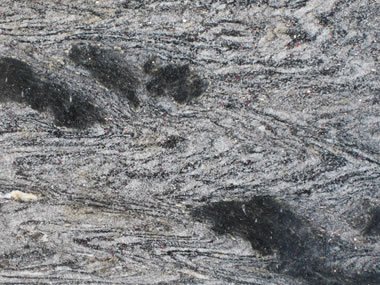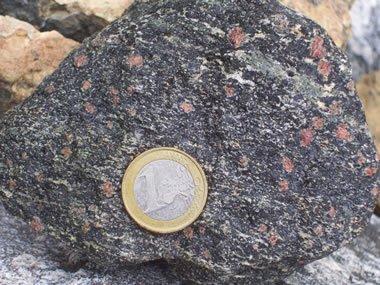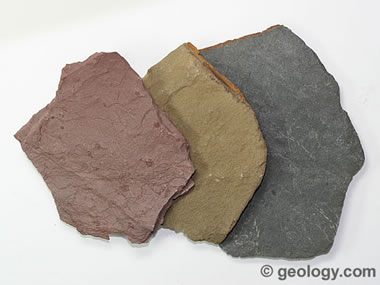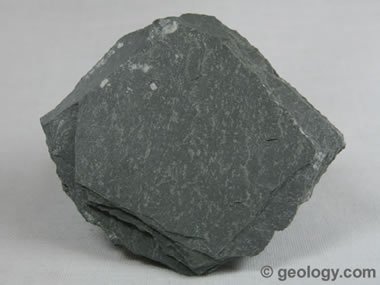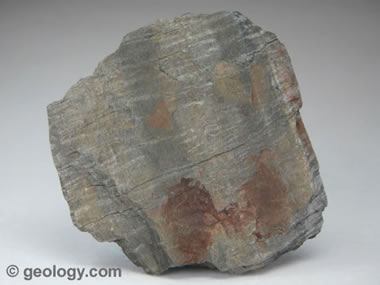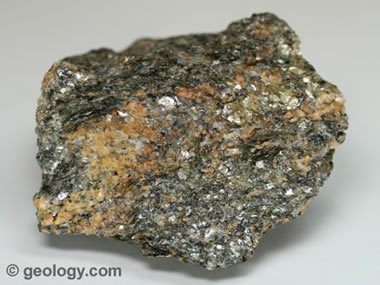|
GC86Z9M
 Golden Gneiss
Golden GneissType: Earth | Size: Other  | Difficulty:
| Difficulty:  | Terrain:
| Terrain:  By: Memfis Mafia @ | Hide Date: 04/27/2019 | Status: Available Country: United States | State: Colorado Coordinates: N39° 42.426 W105° 15.868 | Last updated: 08/30/2019 | Fav points: 0 



What is Gneiss?Gneiss is a foliated metamorphic rock identified by its bands and lenses of varying composition, while other bands contain granular minerals with an interlocking texture. Other bands contain platy or elongate minerals with evidence of preferred orientation. It is this banded appearance and texture - rather than composition - that define a gneiss.
Gneissic Granodiorite: An outcrop of gneissic granodiorite in the Zarembo Island area of southeastern Alaska. How Does Gneiss Form?Gneiss usually forms by regional metamorphism at convergent plate boundaries. It is a high-grade metamorphic rock in which mineral grains recrystallized under intense heat and pressure. This alteration increased the size of the mineral grains and segregated them into bands, a transformation which made the rock and its minerals more stable in their metamorphic environment. Gneiss can form in several different ways. The most common path begins with shale, which is a sedimentary rock. Regional metamorphism can transform shale into slate, then phyllite, then schist, and finally into gneiss. During this transformation, clay particles in shale transform into micas and increase in size. Finally, the platy micas begin to recrystallize into granular minerals. The appearance of granular minerals is what marks the transition into gneiss. Intense heat and pressure can also metamorphose granite into a banded rock known as "granite gneiss." This transformation is usually more of a structural change than a mineralogical transformation. Granite gneiss can also form through the metamorphism of sedimentary rocks. The end product of their metamorphism is a banded rock with a mineralogical composition like granite.
Folded Gneiss: A photograph of polished gneiss from the stock of a countertop vendor. The view shown in the photo is about 12 inches across. Composition and Texture of GneissAlthough gneiss is not defined by its composition, most specimens have bands of feldspar and quartzgrains in an interlocking texture. These bands are usually light in color and alternate with bands of darker-colored minerals with platy or elongate habits. The dark minerals sometimes exhibit an orientation determined by the pressures of metamorphism. Some specimens of gneiss contain distinctive minerals characteristic of the metamorphic environment. These minerals might include biotite, cordierite, sillimanite, kyanite, staurolite, andalusite, and garnet. Gneiss is sometimes named for these minerals, examples of which include "garnet gneiss" and "biotite gneiss."
Garnet Gneiss: A coarse-grained gneiss composed mainly of hornblende (black), plagioclase (white), and garnet (red) from Norway.
The Rocks
What is Shale?Shale is a fine-grained sedimentary rock that forms from the compaction of silt and clay-size mineral particles that we commonly call "mud." This composition places shale in a category of sedimentary rocks known as "mudstones." Shale is distinguished from other mudstones because it is fissile and laminated. "Laminated" means that the rock is made up of many thin layers. "Fissile" means that the rock readily splits into thin pieces along the laminations.
Shale: Shale breaks into thin pieces with sharp edges. It occurs in a wide range of colors that include red, brown, green, gray, and black. It is the most common sedimentary rock and is found in sedimentary basins worldwide.
What is Slate?Slate is a fine-grained, foliated metamorphic rockthat is created by the alteration of shale or mudstone by low-grade regional metamorphism. It is popular for a wide variety of uses such as roofing, flooring, and flagging because of its durability and attractive appearance. |
| Custom URLs |
Add cache to watch list
Log your visit
Picture Gallery
| Additional Waypoints (2) |
| Code | Name | Type | Comments | Date | Coordinates | Distance |
| 0186Z9M | Gneiss | Reference Point | Gneiss Formation | 04/27/2019 | N 39° 42.420 W 105° 15.850 | 0.03 kms SE |
| 0286Z9M | Parking | Parking Area | N 39° 42.426' W 105° 15.868' | 04/27/2019 | N 39° 42.426 W 105° 15.868 | 0.00 kms N |
| Hints |
You can view and answer all questions from the west side of the road. There is plenty of space to park in the pull off. If you chose to cross the street to get a closer look at the rocks use caution and watch for traffic.
| Nearby Caches |
GC6GK18 Mossy Rock (4.50 kms NE)
GC51D0 Mondo's Mt. Galbraith Cache (6.46 kms N)
GC1BP9E Mondo's Ponder the Pole (8.03 kms NE)
GC1BP8E Mondo's Hot Chocolate#4 (8.47 kms NE)
GC1BP90 Mondo's Tee Shot (8.68 kms NE)
Driving Directions
| Logs |
12 Logs: ![]() 12
12
![]() 10/13/2019 By pickledherrings
10/13/2019 By pickledherrings
I left early this morning from Granby heading back home via Denver after enjoying most of the week at K9 Nosework camp. I pick a couple earth caches to stop at on the way, but this one was a happy accident. What a great stop! Thanks for the opportunity to stop and enjoy the beautiful formation!
![]() 10/13/2019 By grizzlycacher
10/13/2019 By grizzlycacher
Earthcaches are my favorite, but I resisted this close one because I knew I would need one for International Earthcache Day. I was busy all day yesterday so I came out for this today and did a few others along the way home. Answers sent. Thanks for an interesting and challenging EC.
![]() 10/13/2019 By Scaber
10/13/2019 By Scaber
I was saving this Earthcache for the International Earthcache Day weekend. Being color blind, some of the color based mineral questions are difficult for me. Picture posted and email on its way. Thank you for creating this Earthcache and helping to keep our recreation going.
![]() 10/12/2019 By WalkingDuo
10/12/2019 By WalkingDuo
I was viewing from the south side of the road when a rock tumbled from the top and shattered on the road so I crossed to clear it off and got up close to the gneiss. Kept an eye out for surprises from above.
![]() 09/30/2019 By CAT DUDE
09/30/2019 By CAT DUDE
found with march boys today
![]() 07/03/2019 By tugies
07/03/2019 By tugies
Glad to see a new cache here, especially and earthcache! Giving a favorite point. Answers sent. Thanks for the fun, Memfis Mafia!
![]() 06/29/2019 By Kroozer
06/29/2019 By Kroozer
Stopped by the rock formation to gather information and take pictures. Messaged answers to cache owner. Thanks for the interesting earthcache!
![]() 05/17/2019 By Greasepot
05/17/2019 By Greasepot
Since I cache paperless, I brought my camera and took some pictures, so I could answer the questions when I got home. I was in the area today, so dropped by to get this earthcache. Thanks!
![]() 05/16/2019 By suntse
05/16/2019 By suntse
Stopped by on the way to Bill's grave. Answer to the best of my ability have been sent on 5/18/19
TFTC
![]() 05/04/2019 By Trea
05/04/2019 By Trea
On a fun caching trip through Colorado and Utah with Huff-Suter, who sent in our answers.
![]() 05/04/2019 By Huff-Suter
05/04/2019 By Huff-Suter
Thanks for the geology lesson and bringing us to another beautiful site. Answer have been sent!
![]() 05/02/2019 By LostinDenver
05/02/2019 By LostinDenver
CO-[FTF] with Windatmyback on 05/02/2019 at 3:40 pm. I was returning from a trip to Nepal when my FTF notification told me about a new Earthcache. I thought for sure that someone would find it before my plane touched the ground. Unfortunately, I returned with a nasty cold and have been down for the count since I returned on April 28, late at night.
Fast forward a few days and I'm still not feeling well. But this Earthcache still hasn't been discovered!! I'll be the first to tell you - I don't like earthcaches. I'm not a geologist or biologist and most earthcaches seem to be made for people much smarter than me. But there are several challenge caches which require a certain number of Earthcache finds, so I look for them.
I printed out the cache info (in case I lost phone reception) and headed out with WAMB. Once at the scene of the crime, I saw that the answers were pretty direct and easy to answer with the guidance already provided by the CO! Sent the answers and got confirmation that they were good. Thanks for the new Earthcache! And, TFTC!

